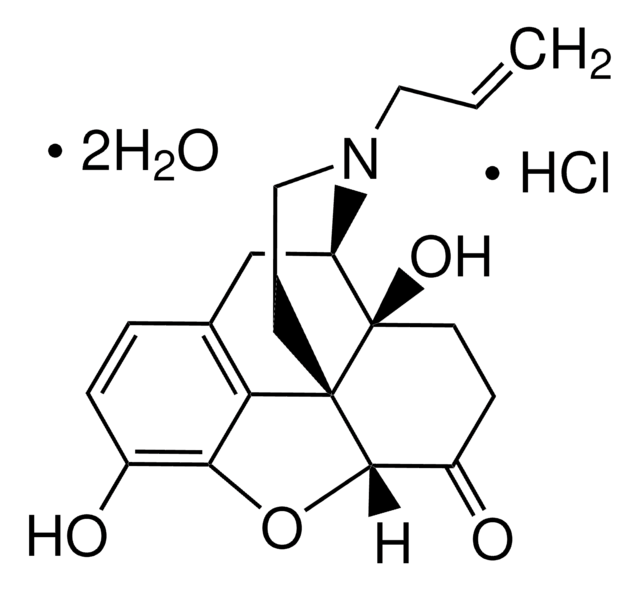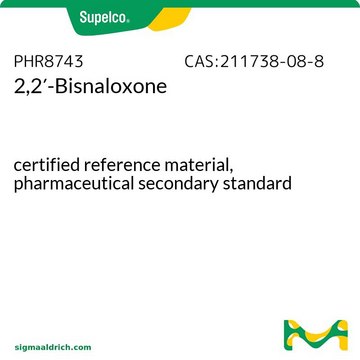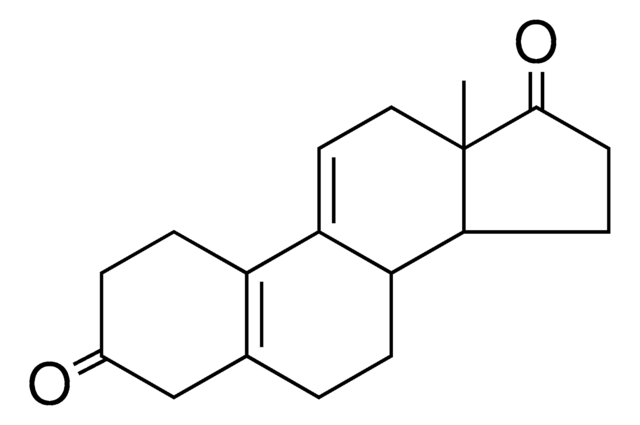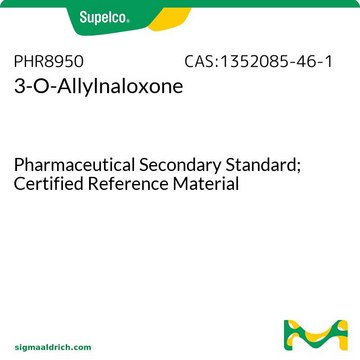1453049
USP
Naloxone Related Compound D CII
United States Pharmacopeia (USP) Reference Standard
Synonym(e):
(4R, 4aS, 7aR, 12bS)-3-allyl-4a,9-dihydroxy-2,3,4,4a-tetrahydro-1H,4,12- methanobenzofuro[3,2-e]-isoquinolin-7(7aH)-one
About This Item
Empfohlene Produkte
API-Familie
naloxone
Verpackung
pkg of 25 mg
Hersteller/Markenname
USP
Anwendung(en)
pharmaceutical (small molecule)
Format
neat
Lagertemp.
2-8°C
Allgemeine Beschreibung
Anwendung
- Interactive effects of opioid and adrenergic-α2 receptor agonists: Research highlights the complex interactions between µ-opioid and adrenergic-α2 receptor agonists in rats, focusing on the primary Kratom alkaloid Mitragynine and its metabolite 7-Hydroxymitragynine. This study is pivotal for understanding the biochemical pathways involved in opioid receptor antagonist research, offering insights into naloxone-related compound applications in opioid addiction and withdrawal management (Hiranita et al., 2022).
- Diels-Alder reactions of morphinan derivatives: The synthesis and transformations of Diels-Alder adducts of morphinan-6,8-dienes are discussed, illuminating the role of naloxone analogs in synthesizing novel opioid receptor antagonists. These findings contribute to the opioid antagonist research, particularly in exploring structural analogs of naloxone for enhanced therapeutic effects (Marton et al., 2022).
- Impact of brain metastases on methylnaltrexone: A post hoc analysis of three randomized studies investigates the influence of brain metastases on the CNS effects of methylnaltrexone. This research underlines the importance of naloxone derivatives in modifying opioid-induced side effects, which is crucial for the development of safer opioid antagonists in supportive cancer care (Brenner et al., 2021).
Hinweis zur Analyse
Sonstige Hinweise
Signalwort
Warning
H-Sätze
Gefahreneinstufungen
Acute Tox. 4 Oral
Lagerklassenschlüssel
13 - Non Combustible Solids
WGK
WGK 3
Flammpunkt (°F)
Not applicable
Flammpunkt (°C)
Not applicable
Analysenzertifikate (COA)
Suchen Sie nach Analysenzertifikate (COA), indem Sie die Lot-/Chargennummer des Produkts eingeben. Lot- und Chargennummern sind auf dem Produktetikett hinter den Wörtern ‘Lot’ oder ‘Batch’ (Lot oder Charge) zu finden.
Besitzen Sie dieses Produkt bereits?
In der Dokumentenbibliothek finden Sie die Dokumentation zu den Produkten, die Sie kürzlich erworben haben.
Unser Team von Wissenschaftlern verfügt über Erfahrung in allen Forschungsbereichen einschließlich Life Science, Materialwissenschaften, chemischer Synthese, Chromatographie, Analytik und vielen mehr..
Setzen Sie sich mit dem technischen Dienst in Verbindung.






